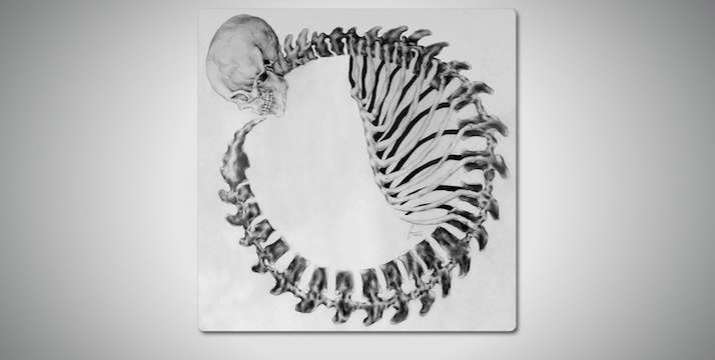FEATURES|COLUMNS|Silk Alchemy
The Iconography of Nagas, Part Six: Finding True Meaning
 A representation of the ouroboros motif—a serpent eating its own tail. Image courtesy of the author
A representation of the ouroboros motif—a serpent eating its own tail. Image courtesy of the authorThere is great transformative power in the act of discovery. No founder of any religion was a follower. The Buddha became the Buddha because he discovered important truths for himself. Many remarkable people following within his tradition also came to that understanding themselves. The same is true of the founders and remarkable followers of every other major world religion. Each brought forth new insights and understanding. Everyone is capable of that; you just need the right conditions. Joining a religion or studying its wisdom can be one of those conditions. But I have studied Buddhist philosophy for over a decade, and I can tell you that such study is not sufficient in order to find true meaning. Only if your own understanding is rooted profoundly within will you be able to awaken spiritually. Only you can understand your life and find its deepest meaning.— His Holiness the 17th Karmapa*
As Buddhists, the great masters remind us that we must question and research, not blindly follow, nor fall into the piousness of mindless routine. And, to be honest, I am an authoritarian’s worst nightmare as cannot help but ask questions, to dig deeper until I have a semblance of an answer as to “why?” Even if that answer ends up being simply “why not?” And even when understanding results in my being able to utterly release it all and return to simply “being,” as is almost always the case.
But more importantly in this exploration of things outside of strict doctrine, we may actually learn something we might never have otherwise, thus enriching our lives just a little more. Today, for example, many living masters are advocates in the fields of neuroscience and quantum physics.
In this series of essays, I have peeked into some of the more rationalistic explanations of the potential roots of serpentine mythology as points of consideration, rather than simply repeating stories found around the world. Fortunately, there are many scholarly articles out there that will satisfy that narrative. This is the final installmentof my six-part series.
In researching this series, I presented strong arguments that indicate humanity is far older than classically credited; that most creational stories involve serpent imagery and that it may relate to a pre-historic global cataclysmic event involving an asteroid impact; that human tribes frequently traveled and migrated; that the fundamental nature of reality is essentially empty and what there is entangles and resembles a serpentine wave pattern; that we live in a tiny percentile of the known universe; and that the body holds more mysteries than we had previously understood.
In her book Rites and Symbols of Initiation (Spring Publications 1998), Mircea Eliade states: “The ritual swallowing by the Snake is to be interpreted as a return to the womb—on the one hand because the Snake is often described as female, on the other because entering the belly of the divine also carries a symbolism of return to embryonic state. It represents not so much a ritual death followed by resurrection as a complete regeneration of the initiate through his gestation and birth by the Great Mother.”

This panel from the tomb of TuenKhamun shows the two ouroboros
serpents—one around the feet and one around the head.
Image courtesy of the author
It is clear that many cultures have viewed the serpent as a powerful totem of an alchemical process of renewal, rebirth, and even transfiguration—the death of one state and the reincarnation of another, in the context of the endless cycle of samsara, as well as regenesis within a single lifetime. A lifetime of emotional changes physically founded by the building blocks of DNA.
In Part Three, I referenced the co-discoverer of DNA, Francis Crick, who suggested that our DNA was so complex in its encoding (215 million gigabytes of information can be stored in a single gram of DNA) that he believed it could not possibly have simply evolved on Earth and was therefore surely a result of panspermia. But even assuming a purely Earthly evolution, while our hominid genome can be traced with reasonable accuracy, what scientists are discovering is that ancient DNA points to far more interbreeding and global migration than previously thought. More interestingly, science shows us that, at the sub-atomic level, information is gathered and stored (See Part Five),and researchers now also tell us that DNA can retain ancestral memories that we can access, although this generally takes place unconsciously. We carry these memories from humanity’s distant past within our core.
It was generally accepted by many scientists that approximately a mere 10 per cent of our DNA had a functional role. Yet ongoing research on the remaining 90 per cent that was considered superfluous appears to be more interesting than previously thought. Of particular interest is the non-coding DNA outside of our genes, and current academic research into human-specific brain-related DNA pieces. Researchers refer to this area as the unknown “dark matter” in DNA stranding that relates to memory and intelligence. And while it currently focuses primarily on the hippocampus, given its proximity to the pineal gland and all the cerebrospinal fluid (CSF) in the area, could there be a link to this METAtonin?
Nagas have traditionally been referred to as water dwelling. A winding river resembles the serpent form. When there is a rainbow, there’s the promise of rain. Rainbow bridges, serpents, and dragons, (and eagles for that matter) are found in nearly every culture—from Australia and South America to Norse creational myth. And clearly, where there is water, there is life. The human body is composed of 70 per cent water. Water is also considered our emotional body, our intuitive state. However, the most extraordinary liquid traversing our system is CSF as it snakes up and down the spinal column and wraps around and in our brain.
Many researchers even suggest that much of our DNA is awaiting activation through mindfulness practices: meditation, yoga, Kundalini awakening, tribal dance, sound healing, mantra recitation, and so on, the conjecture being that the vibrationsin our CSF could affect METAtonin inthe pineal gland, opening a clear channel of relationship with dimensions beyond our limited state of consciousness. Is there a possibility that snakes were so often represented in a double helix form in reference to any of this? And what esoteric knowledge did the ancients already possess?
The classic back straight, head slightly lowered posture has always been important in meditation, and yoga practices focus on rhythmic breath (which has a direct impact on the brain), spinal flexibility, and mental focus on the energies flowing up and down the spine.
In summary, on a purely subjective, biological level, the serpent image, beyond representing spermatozoa, is quite possibly simply the spinal column itself, while serpentine energy is the watery CSF, very much influenced by our emotional state and its direct influence on the brain. How this relates or communicates with dimensions outside of our own small field of normal awareness becomes a far more interesting question.
Given that humans are clearly much older than we are classically taught, serpent iconography may well have been a symbolically convenient way to represent the spine and brain. It was quite likely also used as a poetic reference to a meteor impact that had globally devastating consequences, and the resulting nomadic survivors, some of whom may have migrated from a Kushite city called Naga.
It also seems likely that serpentine entities dwelling just outside of our typical field of perception may be the reason for this universal relationship with snakes and why we hold the serpent in such veneration. Either as a root race, as some suggest; guardians of nature (who would justifiably be pretty upset with us humans these days), or as a distinct species vibrating somewhere outside of our perceivable reality, yet present for any of us to interact with once we recognize the miraculous energetic world for what it truly is: alive. For those who discuss their psychedelic (in the ancient Greek sense of the word**) experiences, snakes are a common vision or manifestation. And “soul-revealing” would seem the evolution of meditative practices beyond mind training and emotional health.
One thing is certain: the serpent as a zoomorphic manifestation of wisdom perfectly represents the cyclic nature of existence. For the new to become, everything that was has to be surrendered. As we see in pagan religions that worship nature and the natural cycles of the seasons, in the darkest, bleakest days of winter, we welcome the promised return of light and warmth. The leaves fall followed by their decay, but this also feeds and readies the resting ground for fresh, new growth. Itis the same when we say goodnight to the sun and greet the nocturnal lunar energy: we rest our bodies and allow the activity that takes placein our minds while we sleep to release everything that no longer serves us in order to welcome in the light of a new day.
The serpent eats its own tail for eternity.
[. . .] whenever we embark on a long journey, there will be a sense of death and rebirth. The experiences we will go through will have a transitional quality. Until we reach our destination, we are in transit—in between two points. One world has dissolved, like last night’s dream, and the next has not yet arisen. If we can allow ourselves to accept what is and let go into this space, there is a sense of total freedom: we are free from the business of being our ordinary selves; we are not tied to the day-to-day world and its demands in quite the same way. And in that transition there lays [. . .] a sense of freshness and appreciation of the present moment. — His Holiness the 17th Karmapa*
* The Heart Is Noble: Changing the World from the Inside Out (Shambhala 2014)
** The term “psychedelic”is derived from the Ancient Greek words psychē (ψυχή;soul) and dēloun (δηλοῦν; to make visible, to reveal), translating to “soul-revealing.”
See more
Ancient DNA Is Rewriting Human (and Neanderthal) History (The Atlantic)
Quantum entanglement between a single photon and a trillion rubidium atoms (Phys.Org)
Is "Junk DNA" What Makes Humans Unique? (Scientific American)
DNA could store all of the world's data in one room (Science)
Engineering of Multi-Dimensional Entangled States of Photon Pairs Using Hyper-Entanglement (IOP Science)
Related features from Buddhistdoor Global
The Iconography of Nagas, Part One: Serpentine Folklore from the Abyssal Chasm
The Iconography of Nagas, Part Two: Syncretism and Science
The Iconography of Nagas, Part Three: DNA in History
The Iconography of Nagas, Part Four: Chaos and Creation
The Iconography of Nagas, Part Five: Prajnaparamita and the Nature of Reality
















